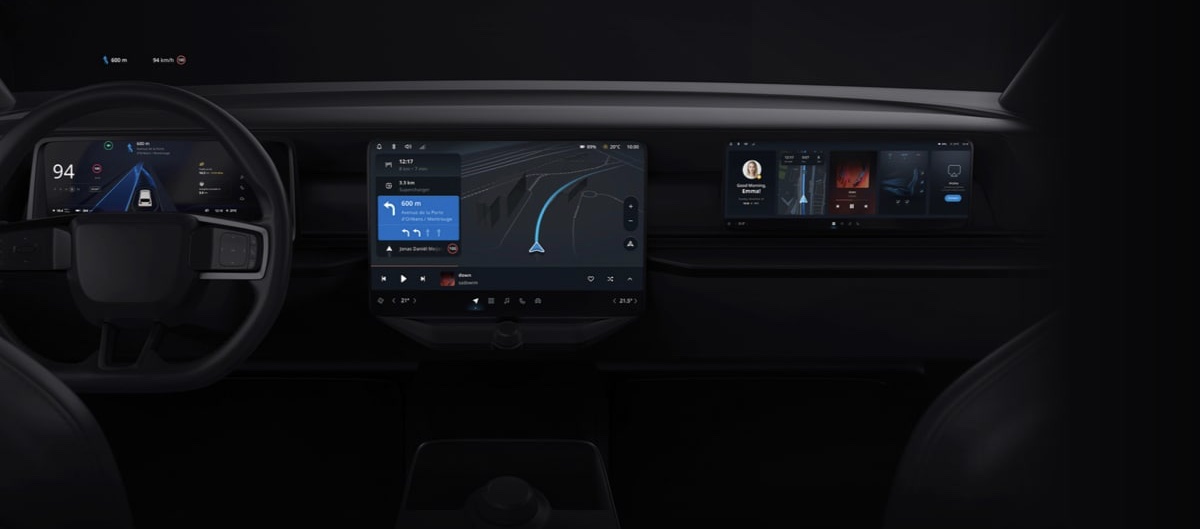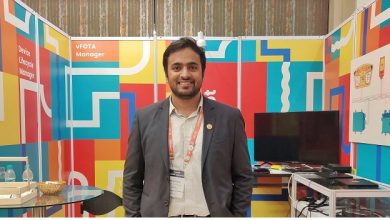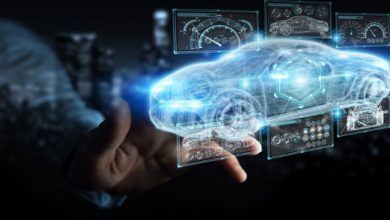The in-vehicle experience will see automotive’s next big disruption: Digital cockpits and the future of IVI

The automotive world is being forced to evolve to growing customer demands and increasing societal pressures. Drivers want true mobile app integration, not systems that piggyback the car’s IVI; they want richer in-vehicle experiences and high-level automated driver aids (ADAS). Alongside this, society is pushing the transition to electric power and for improvements in vehicle safety.
This shift to EVs isn’t just challenging drivetrain engineers. In-car user interface designers are up against it too. They must define how to share critical EV information, like battery state and charging locations, with drivers. Carmakers also must figure out how to build IVI systems faster, so that they mirror our digital lives, where apps and features are developed and updated regularly. On top of that, they must develop ways to keep IVI systems fresh for the life of the vehicle.
What’s happening for carmakers, suppliers and OEMS is more revolution, than evolution. Revolution brings big changes in how business is done. While it’s too soon to say exactly how the industry will change and restructure, automotive businesses are beginning to see what lies ahead and what they must do to capitalize.
Cesar Arego, Business Development Manager Digital Cockpit at TomTom, says we’re witnessing a new wave of disruption in automotive. We sat down with Cesar to find out how the automotive world is changing and what carmakers need to do to prepare for what lies ahead.
What are some of the biggest challenges and changes you’ve seen in the automotive industry?
When I first started 15 years ago, infotainment system integrators and tier ones were doing everything on their own. This has been the source of many challenges and changes that followed.
Back in those days, tier ones would take a map from a supplier, like TomTom or its competitors, and do something called compilation. This is essentially repackaging the map for their own applications. In some cases, it took hundreds of people to repack the map; each car line, each customer and each car brand getting a slightly different flavor.
In parallel to map compilation, using the repackaged maps, tier ones began developing in-vehicle infotainment (IVI) navigation software by themselves, for a small number of luxury-focused clients. But creating navigation systems is very labor- and capital-intensive. These companies constantly faced resource, engineering and development challenges. It was a laborious process and ultimately proved unsustainable.
What were the problems with the way those IVI systems were being built? And how did this change?
Compiling maps and building navigation systems in this way gave developers at tier ones a lot of control, but this was not the tier one’s core focus — making it difficult for them to offer best in class products. They were also rebuilding a map and satnav for each IVI system and car. It was a lot of repetitive work.
Early IVI systems needed to be developed in this way to coincide with vehicle development lifecycles. Software had to be locked in up to a year before the car entered production and couldn’t be modified afterwards. By the time the car model reaches the end of its production life, the IVI software could be up to eight years old.
That way of development doesn’t allow carmakers to meet the expectations of modern drivers. It’s an inefficient way of doing business. With key software disruptions arriving to the industry, how IVI systems are developed is evolving and it’s allowing carmakers, suppliers, tier ones and OEMs to explore new, more collaborative, ways of doing business.
Some carmakers now are making IVI systems and digital cockpit software much faster — in just 18 months. What’s more, they’re doing it alongside the development of the vehicles. Locking software in years ahead of production is becoming a thing of the past.
We’re at the dawn of a third wave of disruption in automotive, in-vehicle tech. Tier ones were doing it all. All the software structure from the bottom up themselves. And now we are seeing, with the arrival of Android Automotive, a new way to build digital cockpits. One which will provide better solutions for everybody.
What’s the most significant change you’ve seen inside the vehicle? What disruptions lead to this?
In a first wave of disruption, we saw the invention of high-tech IVI systems. After this, a second wave brought a reconfiguration of how these systems are made.
After many years dedicating their scarce resources to making mapping and navigation systems, car companies and tier ones pursued more cost effective and efficient means of production by partnering with mapping and navigation specialists, like TomTom. The thinking was, “Let them figure out how to make the best possible navigation and we’ll take care of everything else.”
In fact, back in 2012, a Japanese carmaker came to me and asked if we could take over map compilation. As it had been a focus for us, we’d gotten quite good at it and were able to recompile maps faster and more frequently — four times a year. The automaker was only able to get it done once a year.
Little by little, we’ve seen carmakers, OEMs and tier ones drop their navigation departments and dedicate their valuable resources to other parts of the infotainment system — that’s what they are experts on. This has allowed them to make highly functional, and high performing in-vehicle systems, whilst also delivering useful and accurate mapping and navigation that keep up with changes in the world.
And now, we’re at the beginning of a third wave of disruption with the arrival of Android Automotive. It’s presenting carmakers with more choice and opportunity with how they make their in-vehicle systems. And, I think, it’s the start of a new era of digital cockpits, which will be more intuitive, feature rich and constantly evolving- ones which provide an experience much closer to our mobile phones.
All these changes boil down to speed. The first and second waves of disruption allowed car companies to deliver fresher navigation through faster and more frequent map compilation and navigation system development. And now, the latest wave of disruption allows a faster and more frequent update of the entire IVI creation framework.
When talking about digital cockpits, mobile phones are frequently mentioned. It’s become a benchmark for the automotive industry, tell me about that.
The mobile phone has become a benchmark through its ubiquity and because phone experiences are more modern than what we have in cars. The software for a phone might be locked in just weeks before it enters production, most cars are locked in up to one year before they roll off the production line. By the time you’re driving the car, it feels old compared to other tech in your life.
We’re incredibly familiar with their user experiences too. Drivers expect that phone experience in their vehicles. Drivers want regular updates, high-definition displays, they want their favorite music app, they want their calendars to sync with the navigation to offer routes based on where they need to be and when.
Also, phones are continuously updated. Apps are refreshed and new apps keep the experience fresh and relevant. The predominant IVI systems in the market today are fixed for the life of the car, though there are some exceptions to that rule. Over-the-air updates are still unusual in the auto industry.
What will this third wave of disruption bring? How does the industry need to adapt to this?
I think with this disruption, comes empowerment. In short, with Android Automotive, carmakers, tier ones and suppliers will be better positioned to work together, focus resources and work quickly to build IVI systems.
The expectations of drivers today mean that carmakers can no longer lock software in years before production. They must be more agile, flexible and design systems to be updatable. They need to work faster.
I want to see more collaboration in the industry. I want to see tier ones, OEMs, carmakers and suppliers work together to bring all areas of our expertise together. By focusing their dedicated resources on fine tuning their digital cockpit and using the best parts of what the IVI industry has to offer, carmakers will be able to create sexy software in the car. And thanks to the collaboration, how much of that development the carmaker does, will be its own choice.
An EV startup can choose premade apps and services to get moving quickly, while a big OEM can make a larger part themselves on top of Android Automotive. It’s the same platform, but flexible to the needs of the company.
It’s like an all-star rock ‘n’ roll band. Bringing together best in the industry, the best bass, the best guitar, vocalist and producer. When they are supported to play together, they’ll make the best music. The challenge will be getting everyone to work together!
This amount of collaboration is a totally new way of working, but it’s one that must happen if carmakers are going to make the in-vehicle experiences that drivers and passengers will love.
What will digital cockpits of the future look like?
The car of today is very different to that of 20, 10, or even five years ago. Drivers expect to get in the car and have what was playing on their phone’s music app pop up on their infotainment screen. They expect those screens to be high definition and have a beautiful interface. Drivers expect their digital lives to seamlessly merge into their vehicles. 10 years ago, this was a dream, but now, it’s a possibility. Soon these kinds of features will be the things every carmaker needs to offer to be competitive.
Digital cockpits of the future will need to be intuitive, easy to use, great looking and offer seamless integration with mobile apps. For carmakers and OEMs, the future of how digital cockpits are made will enable faster time to market, more customization and deep integration of ADAS and EV features with navigation. Once the initial foundation is built, IVIs need only be tailored for each vehicle, not rebuilt from scratch.
What does the industry need to know to be able to respond to the disruption of how digital cockpits are made?
There’ll be a lot of work at the beginning, building the foundation of the IVI system. But carmakers should invest in it! The payoff will come later when auto brands won’t have to re-develop the same system over and over.
When starting on this digital cockpit journey, I would advise carmakers to really do their homework first. To find out who the best suppliers and collaborators are for the features they want to add to their digital cockpit.
Perhaps it’ll be the OEMs that have the biggest task, as they’re like the rock ‘n’ roll band’s producer! They’re the ones that must orchestrate the collaboration and bring everything together. But, as I said, when they do, great music will be made.
Carmakers will also have to exploit the faster time to market and be reactive to user and industry feedback. There are many consumer reports that rank IVI systems on their speed, freshness and functionality. If you don’t score highly on these third-party tests, you’re not going to be taken seriously. So, automakers, OEMS and everyone else needs to be ready to respond to these results and build the features drivers want.
How is TomTom helping carmakers build the most exciting and fresh digital cockpits?
TomTom was part of the first two waves of disruption and it’s very much driving the third. TomTom is helping push digital cockpits forward with our own platform: the TomTom Digital Cockpit.
It’s an open, Android Automotive-based system, that’s designed with flexibility, modularity and modern driving experiences in mind. We say it’s sort of like Lego, the foundation is the same whatever you do with it, and then on top of this, you can drop pre-made blocks to build a fully functional digital cockpit, or you can build your own blocks to create something more bespoke.
TomTom’s Digital Cockpit platform brings with it a growing ecosystem of big-name partners too. So, while there’s going to be more collaboration in the industry, TomTom is doing its best to take the pain out of having to collaborate with potentially hundreds of partners and app providers.
This means, through TomTom, carmakers will get access to products, services and apps from the likes of Spotify, Amazon Alexa, Amazon Music, but also region-specific services, like those in India from Quest Global, for engineering, or Gaana, for music. Working in this way gives quick, easy and customizable access to voice assistants, system integrations and entertainment apps.

Digital cockpits built on TomTom’s platform are easily tailored and visually altered for each car model. They can also be updated over-the-air, letting carmakers keep their in-vehicle experiences fresh, modern and up to date for the changing needs of drivers.
As we did with map compilation, and then navigation systems, what we’re trying to do is help the automotive industry make the best use of its limited resources and bring together the best partners in the world. Tier ones, OEMs and suppliers are all experts in their core business, if we create an industry where each player can focus on what they do best — if we create a platform that allows carmakers to iterate IVIs faster and more frequently — we’re going to create the wonderful digital cockpits and in-vehicle experiences that drivers are demanding.
But it will need a completely new way of working. More collaboration! Like the all-star band coming together! Hopefully, TomTom’s platform helps the band (or carmaker) make the best music they can.
More about the expert, Cesar Arego
Cesar Arego is TomTom’s Business Development Manager in its Digital Cockpit division. Cesar’s work sees him support the automotive industry for in-vehicle navigation and infotainment technologies in the cockpits of today and the future.





